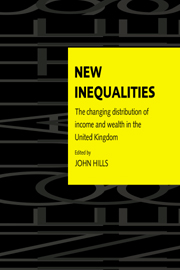Book contents
- Frontmatter
- Contents
- List of figures
- List of tables
- List of contributors
- Acknowledgements
- 1 Introduction: after the turning point
- Part I Income distribution
- Part II Components of income
- 6 What has happened to the wages of men since 1966?
- 7 Women's pay and family incomes in Britain, 1979–91
- 8 More work in fewer households?
- 9 Self-employment and the distribution of income
- 10 Fairer or Fowler? The effects of the 1986 Social Security Act on family incomes
- Part III Spatial aspects
- Part IV Income and wealth
- Bibliography
- Index
9 - Self-employment and the distribution of income
from Part II - Components of income
Published online by Cambridge University Press: 22 September 2009
- Frontmatter
- Contents
- List of figures
- List of tables
- List of contributors
- Acknowledgements
- 1 Introduction: after the turning point
- Part I Income distribution
- Part II Components of income
- 6 What has happened to the wages of men since 1966?
- 7 Women's pay and family incomes in Britain, 1979–91
- 8 More work in fewer households?
- 9 Self-employment and the distribution of income
- 10 Fairer or Fowler? The effects of the 1986 Social Security Act on family incomes
- Part III Spatial aspects
- Part IV Income and wealth
- Bibliography
- Index
Summary
Introduction
Self-employment in the United Kingdom grew extremely rapidly during the 1980s, in comparison both with historical experience, and with what was happening in other industrialised economies. Self-employment almost doubled over the period 1979–89, such that by the end of this period one in eight of those in work was self-employed. There is no simple or single explanation for this development, and the extreme heterogeneity of the self-employed as a group makes it unlikely that one model or theoretical framework can account for aggregate trends in self-employment. The definitions of self-employment are various, but most encompass a wide spectrum, from independent ‘entrepreneurs’ and traditional small business owner-proprietors at one extreme, to relatively unskilled construction and service sector workers at the other. The latter are often highly dependent on large organisations for their livelihoods, and their ‘self-employment’, in many cases, differs from dependent or wage employment in name only.
Recent research, drawing on the European Labour Force Surveys (Meager, 1993) shows that UK self-employment has not only grown rapidly, but has become highly ‘dynamic’, with higher rates of inflow and outflow than in most other European countries. This implies that for a given stock of self-employment in the United Kingdom, a larger proportion of the working population experiences spells of self-employment during their working lives than is the case in other countries. Experience of self-employment may, therefore, have become even more widespread within the working population than the total self-employment figures themselves suggest.
- Type
- Chapter
- Information
- New InequalitiesThe Changing Distribution of Income and Wealth in the United Kingdom, pp. 208 - 235Publisher: Cambridge University PressPrint publication year: 1996
- 8
- Cited by



